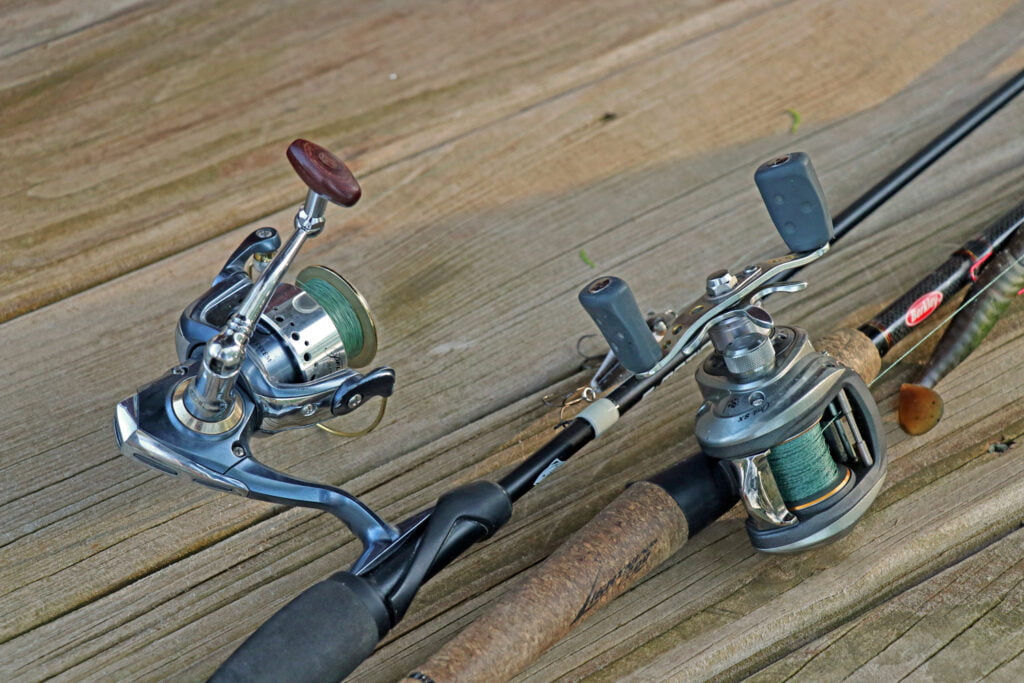
What kind of rod and reel should I use?
Hey there, fellow angler! If you’re anything like me, you’ve probably spent countless hours dreaming about hooking into a monstrous catfish. Those whiskered giants are not only thrilling to catch but also make for some delicious meals. But before you head out on your next catfishing adventure, let’s talk about one of the most critical aspects of your setup: your rod and reel combo.
Believe me, I’ve been through my fair share of trial and error, and I’ve discovered that finding the right rod and reel for catfishing isn’t a one-size-fits-all deal. It’s all about understanding your unique fishing style, the type of catfish you’re targeting, and the waters you’re fishing in. So, grab a cup of coffee, sit back, and let’s dive into the fascinating world of catfishing gear.
The Lowdown on Catfishing
Before we get into the nitty-gritty of rod and reel selection, let’s briefly discuss what catfishing is all about. Catfish are known for their impressive size and strength, and they come in various species such as channel catfish, blue catfish, and flathead catfish. The thrill of catfishing lies in the anticipation of that mighty pull on your line, as you tangle with a creature that can weigh more than you do.
Catfish are often found lurking in freshwater bodies like rivers, lakes, and reservoirs. They’re notorious for hiding in submerged structures, such as fallen trees and rocks, waiting to ambush their prey. To outsmart these cunning underwater giants, you need the right gear.
Understanding the Basics: Rod and Reel Combo

Okay, let’s get down to business. Your rod and reel combo is like the Batman and Robin of your catfishing setup, and choosing the right pair is essential for success. But, it’s not as straightforward as just picking up any old rod and reel. You need to consider several factors to ensure you’re prepared for any catfish encounter.
1. Rod Length: Long, Short, or Somewhere in Between?
The length of your rod is crucial because it determines your casting distance and control over the fish. Typically, catfish rods range from 7 to 9 feet, but it’s essential to match the rod length with your fishing style and the size of the fish you’re targeting.
- Short Rods (7-8 feet): These are ideal for close-quarters combat and situations where you don’t need to cast too far. If you’re fishing from a boat, near a dock, or in tight spaces, a shorter rod will serve you well.
- Medium-Length Rods (8-9 feet): A medium-length rod strikes a balance between casting distance and control. It’s versatile and can handle a wide range of catfish sizes. This length is my personal favorite for all-around catfishing.
- Long Rods (9 feet and above): Long rods are excellent for bank or shore fishing when you need to cast your bait to a distant spot. They offer more leverage for reeling in larger catfish but can be cumbersome in tight spaces.
2. Power and Action: Getting the Right Balance
When you’re shopping for a catfish rod, you’ll often come across terms like “power” and “action.” These are crucial factors that determine the rod’s strength and flexibility:
- Power: This refers to the rod’s ability to handle heavy loads. For catfishing, you’ll want a rod with either medium-heavy or heavy power. Medium-heavy rods are more versatile, suitable for a variety of catfish sizes, while heavy rods are best for wrestling with giants.
- Action: Action relates to how much the rod bends when you apply pressure to the tip. For catfishing, a moderate to fast action rod is preferred. It provides the sensitivity to detect subtle bites and the backbone to handle powerful hooksets.
3. The Right Reel: Making the Perfect Match
Now that you’ve nailed down the rod, let’s talk about the reel. The reel plays a crucial role in catfishing because it controls the line and helps you land those hefty catfish. Here are some essential considerations when selecting a reel:
- Line Capacity: Catfish can run, and they can run fast. Make sure your reel has enough line capacity to handle the kind of catfish you’re targeting. A reel with a line capacity of at least 200 yards is a good starting point.
- Drag System: A smooth and reliable drag system is essential when battling catfish. Look for a reel with a strong drag that won’t give up when a catfish decides to make a run for it.
- Gear Ratio: For catfishing, a reel with a gear ratio of around 4.5:1 to 6.2:1 is ideal. This range provides a good balance between power and speed, allowing you to handle catfish of various sizes.
4. Baitcasting or Spinning Reel?

This is a hotly debated topic among catfish anglers, and the choice often comes down to personal preference. Both baitcasting and spinning reels have their advantages, so let’s break it down:
- Baitcasting Reel: Baitcasters offer precise control over your line and are excellent for casting heavy baits. They allow for accurate placement of your bait in catfish hideouts, such as submerged logs and brush piles. However, they have a steeper learning curve and may require more practice to master.
- Spinning Reel: Spinning reels are user-friendly and suitable for beginners. They excel at casting lighter baits and are more forgiving when it comes to backlash. If you’re just getting into catfishing, a spinning reel might be the way to go.
Matching the Combo to the Catfish

Now that you have a solid grasp of the fundamentals, let’s talk about how to match your rod and reel combo to the specific type of catfish you’re targeting.
1. Channel Catfish (Ictalurus punctatus):
Channel catfish are known for their scrappy nature and are found in a wide range of freshwater habitats. They typically range from 1 to 15 pounds, but trophy-sized individuals can exceed 30 pounds. For channel catfish, a medium to medium-heavy rod in the 7 to 8.5-foot range paired with a spinning reel with a line capacity of 10-20 pounds should do the trick. Use monofilament or braided line with a size 4/0 to 6/0 circle hook for bait.
2. Blue Catfish (Ictalurus furcatus):
Blue catfish are the true giants of the catfish world, capable of reaching several hundred pounds. To target blues, you’ll need heavy-duty gear. Opt for a heavy power rod in the 8.5 to 9-foot range, paired with a baitcasting reel that can handle 30-50 pound test line. Use a size 7/0 to 10/0 circle hook for bait.
3. Flathead Catfish (Pylodictis olivaris):
Flathead catfish, also known as “yellow cats” or “opossum fish,” are big predators with a preference for live bait. They can reach enormous sizes, so you’ll want a rod and reel combo that can handle the fight. A heavy-power rod in the 8.5 to 9-foot range paired with a baitcasting reel spooled with 20-40 pound test line should be sufficient. Use a size 7/0 to 10/0 circle hook for live bait presentations.
4. Bullhead Catfish (Ameiurus spp.):
Bullhead catfish are the smaller cousins of their larger counterparts, with most species maxing out around 1-2 pounds. For these feisty little fish, a light to medium-light spinning rod in the 6.5 to 7-foot range paired with a spinning reel spooled with 4-10 pound test line is ideal. You can use smaller hooks in the size 1 to 4 range for bullheads.
Consider the Environment
Your choice of rod and reel combo should also take into account the environment you’ll be fishing in. Here are a few environmental factors to consider:
- Structure: If you’ll be fishing around submerged structures like trees or rocks, a shorter rod might be more practical to avoid snagging.
- Current: In fast-moving rivers, you’ll need a sturdier rod and reel combo to handle the current and any potential river monsters.
- Cover: If you’re fishing in heavily vegetated areas, opt for a reel with a good line capacity to handle potential snags.
Accessorize Your Setup
Now that you’ve got your rod and reel sorted, don’t forget to complete your catfishing arsenal with a few key accessories:
- Fishing Line: Choose a high-quality monofilament or braided line that matches your rod and reel specifications.
- Terminal Tackle: Stock up on various sizes of circle hooks, swivels, and sinkers to accommodate different bait presentations.
- Bait: Live bait, cut bait, and prepared baits all have their place in catfishing. Experiment to see what the catfish in your area prefer.
- Tackle Box: Organize your hooks, sinkers, and other gear in a tackle box for easy access on the water.
- Landing Net: A sturdy landing net can help you safely land catfish, especially when they’re too big to lift by hand.
- Pliers and Grippers: These tools are handy for removing hooks and safely handling catfish.

So what kind of rod and reel should I use for catfishing? For catfishing, consider a medium to heavy-power rod (7-9 feet) matched with a spinning or baitcasting reel, depending on your skill level and personal preference.
Remember, the perfect rod and reel combo for catfishing is not one-size-fits-all. It depends on your preferences, the type of catfish you’re chasing, and the waters you’re fishing in. So, don’t be afraid to experiment, ask fellow anglers for advice, and, most importantly, enjoy the journey.
Whether you’re battling monstrous blues in the depths of a river or catching bullheads with your kids by the pond, there’s something uniquely satisfying about catfishing. So, go ahead, unleash the beast, and make some unforgettable memories on the water. Happy catfishing, my fellow angler! Catfishingusa.com Blog

